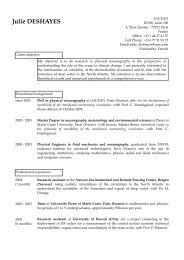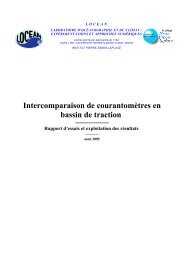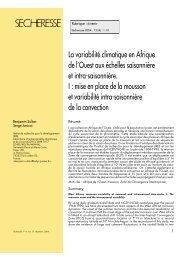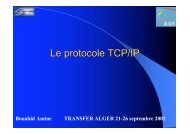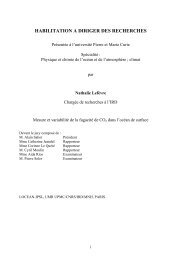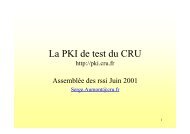PISCES biogeochemical model - NEMO
PISCES biogeochemical model - NEMO
PISCES biogeochemical model - NEMO
You also want an ePaper? Increase the reach of your titles
YUMPU automatically turns print PDFs into web optimized ePapers that Google loves.
Si:C ratio can reach one, a value outside the range of the diagnostic equation proposed by<br />
bucchiarelli et al. (2002). Thus, to mimic this extremely high values in the Southern Ocean<br />
which are associated with the highest silicate surface concentrations, we propose the following<br />
parameterization:<br />
( ) Si opt<br />
C<br />
=<br />
( ) Si opt<br />
C<br />
= min(1,<br />
( ) Si opt<br />
( )<br />
max(0, Si − Simin )<br />
(1 + 3<br />
C<br />
KSi 2 + Si<br />
( Si<br />
C<br />
) opt<br />
) (12)<br />
In this equation, Si min is a parameter that should be set to a relatively high value, typically 15<br />
µmol/L, to restrict the increase to the Southern Ocean.<br />
)<br />
3.5 Equation for microzooplankton<br />
∂Z<br />
∂t<br />
= e micro (g micro (P ) + g micro (D) + g micro (P OC s ))Z 1 − r micro Z<br />
K micro + Z Z (13)<br />
The grazing on each species N is defined as follows:<br />
g micro (N) = g micro<br />
K micro<br />
G<br />
p micro<br />
N N<br />
+ ∑ I<br />
(p micro<br />
I I)<br />
(14)<br />
where p micro<br />
N is the preference microzooplankton has for N and I are all the reservoirs microzooplankton<br />
can graze on.<br />
The grazing rate g micro depends on temperature following exactly the same relationship than<br />
phytoplankton. It means that we assume a Q 10 for zooplankton (both micro and mesozooplankton)<br />
of about 1.9. We have also adopted this dependancy for respiration/mortality.<br />
A special treatment is applied on both types of phytoplankton:<br />
• For nanophytoplankton, a minimum threshold is assumed based on observations showing<br />
that below a certain small chlorophyll concentration, grazing ceases. This threshold is<br />
generally of the order of 0.03 mg Chl l −1 . Thus, for nanophytoplankton, the concentration<br />
in the grazing equation (see Eq. 14) is max(P-P min ,0) instead of P.<br />
• For diatoms, observations show that the biomass increases by the addition of larger cells<br />
which escape grazing by microzooplankton. Thus, we assume in <strong>PISCES</strong> that above a<br />
certain concentration, the diatoms excess is unavailable to microzooplanton. The diatoms<br />
concentration in Eq. 14 is then min(D max ,D).<br />
3.6 Equation for mesozooplankton<br />
∂M<br />
∂t<br />
= e meso (g meso (P ) + g meso (D) + g meso (Z) + g meso (P OC s ) + g meso (P OC b ))M<br />
−r meso<br />
M<br />
K meso + M M − mmeso M 2 (15)<br />
6





